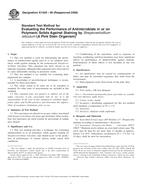Potřebujeme váš souhlas k využití jednotlivých dat, aby se vám mimo jiné mohly ukazovat informace týkající se vašich zájmů. Souhlas udělíte kliknutím na tlačítko „OK“.
ASTM F2739-08
Standard Guide for Quantitating Cell Viability Within Biomaterial Scaffolds
Automaticky přeložený název:
Standardní příručka pro kvantifikaci životaschopnosti buněk v rámci biomateriálu lešení
NORMA vydána dne 1.8.2008
Informace o normě:
Označení normy: ASTM F2739-08
Poznámka: NEPLATNÁ
Datum vydání normy: 1.8.2008
Kód zboží: NS-54463
Počet stran: 6
Přibližná hmotnost: 18 g (0.04 liber)
Země: Americká technická norma
Kategorie: Technické normy ASTM
Kategorie - podobné normy:
Anotace textu normy ASTM F2739-08 :
Keywords:
ICS Number Code 07.100.99 (Other standards related to microbiology)
Doplňující informace
| Significance and Use | ||||||||
|
The number and distribution of viable and non-viable cells within, or on the surface of, a biomaterial scaffold is one of several important characteristics that may determine in vivo product performance of cell/biomaterial constructs (see 5.7); therefore there is a need for standardized test methods to quantitate cell viability. There are a variety of static and dynamic methods to seed cells on scaffolds, each with different cell seeding efficiencies. In general, static methods such as direct pipetting of cells on to scaffold surfaces have been shown to have lower cell seeding efficiencies than dynamic methods that push cells into the scaffold interior. Dynamic methods include: injection of cells into the scaffold, cell seeding on biomaterials contained in spinner flasks or perfusion chambers, or seeding that is enhanced by the application of centrifugal forces. The methods described in this guide can assist in establishing cell seeding efficiencies as a function of seeding method and for standardizing viable cell number within a given methodology. As described in Guide F 2315, thick scaffolds or scaffolds highly loaded with cells lead to diffusion limitations during culture or implantation that can result in cell death in the center of the construct, leaving only an outer rim of viable cells. Spatial variations of viable cells such as this may be quantitated using the tests within this guide. The effectiveness of the culturing method or bioreactor conditions on the viability of the cells throughout the scaffold can also be evaluated with the methods described in this guide. These test methods can be used to quantitate cells on hard or soft 3-D biomaterials, such as ceramics and polymer gels. The test methods also apply to cells seeded on porous coatings. Test methods described in this guide may also be used to distinguish between proliferating and non-proliferating viable cells. Proliferating cells proceed through the DNA synthesis (S) phase and the mitosis (M) phase to produce two daughter cells. Non-proliferating viable cells are in some phase of the cell cycle, but are not necessarily proceeding through the cell cycle culminating in proliferation. Viable cells may be under stress or undergoing apoptosis. Assays for evaluating cell stress or apoptosis are not addressed in this guide. While cell viability is an important characteristic of a TEMP, the biological performance of a TEMP is dependant on additional parameters. Additional tests to evaluate and confirm the cell identity, protein expression, genetic profile, lineage progression, extent of differentiation, activation status, and morphology are recommended. Fundamental biocompatibility testing of the scaffold material itself as described in Practice F 748 should be completed prior to using the biomaterial with cells. |
||||||||
| 1. Scope | ||||||||
|
1.1 This guide is a resource of cell viability test methods that can be used to assess the number and distribution of viable and non-viable cells within porous and non-porous, hard or soft biomaterial scaffolds, such as those used in tissue engineered medical products (TEMPs). 1.2 In addition to providing a compendium of available techniques, this guide describes materials specific interactions with the cell assays that can interfere with accurate cell viability analysis, and includes guidance on how to avoid, and/or account for, scaffold material/cell viability assay interactions. 1.3 These methods can be used for 3-D scaffolds containing cells that have been cultured in vitro or for scaffold/cell constructs that are retrieved after implantation in living organisms. 1.4 This guide does not propose acceptance criteria based on the application of cell viability test methods. 1.5 The values stated in SI units are to be regarded as standard. No other units of measurement are included in this standard. 1.6 This standard does not purport to address all of the safety concerns, if any, associated with its use. It is the responsibility of the user of this standard to establish appropriate safety and health practices and determine the applicability of regulatory limitations prior to use. |
||||||||
| 2. Referenced Documents | ||||||||
|
Podobné normy:
Historická
1.9.2012
Historická
1.6.2014
Historická
1.10.2009
Historická
1.3.2009
Historická
1.4.2008
Historická
1.12.2012



 ASTM D7819-12
ASTM D7819-12 ASTM D7910-14
ASTM D7910-14 ASTM E1428-99(2009)..
ASTM E1428-99(2009).. ASTM E1963-09
ASTM E1963-09 ASTM E2315-03(2008)..
ASTM E2315-03(2008).. ASTM E2317-04(2012)..
ASTM E2317-04(2012)..
 Cookies
Cookies
